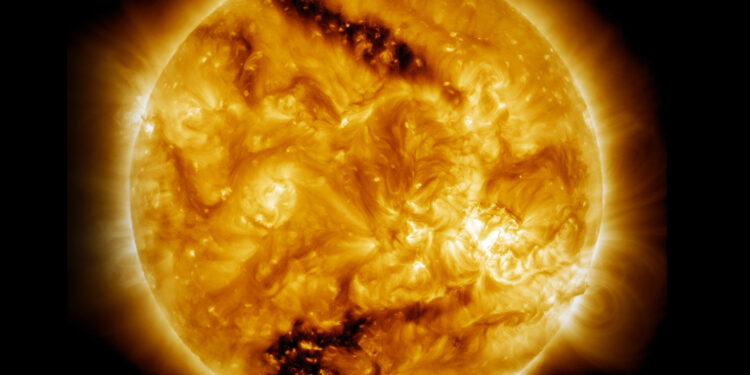Image showing two coronal holes, shown as relatively dark regions. Coronal holes are regions of lower density and temperature in the Sun’s outer atmosphere, known as the corona. Credit: NASA/Goddard/SDO
There is a deep mystery in our sun. While the sun’s surface temperature measures about 10,000 degrees Fahrenheit, its outer atmosphere, known as the solar corona, measures more like 2 million degrees Fahrenheit, or about 200 times hotter.
This increase in temperature away from the sun is perplexing and has remained an unsolved mystery since 1939, when the high corona temperature was first identified. In the decades since, scientists have tried to determine the mechanism that might be causing this unexpected warming, but so far they have been unsuccessful.
Now, a team led by Sayak Bose, a researcher at the U.S. Department of Energy’s (DOE) Princeton Plasma Physics Laboratory (PPPL), has made significant progress in understanding the underlying heating mechanism. Their recent findings show that reflected plasma waves could cause the heating of coronal holes, which are low-density regions of the Sun’s corona with open magnetic field lines extending into interplanetary space. These discoveries represent major progress toward solving one of the most mysterious dilemmas surrounding our nearest star.
“Scientists knew that coronal holes have high temperatures, but the underlying mechanism responsible for the heating is not well understood,” said Bose, the lead author of the paper reporting the results in The Astrophysics Journal. “Our results reveal that reflection of plasma waves can do the trick. This is the first laboratory experiment demonstrating that Alfvén waves are reflected under conditions related to coronal holes.”
First predicted by Swedish physicist and Nobel Prize winner Hannes Alfvén, the waves that bear his name resemble the vibrations of plucked guitar strings, except in this case the plasma waves are caused by undulating magnetic fields.
Bose and other team members used the 20-meter-long plasma column of the Large Plasma Device (LAPD) at the University of California, Los Angeles (UCLA) to excite Alfvén waves under conditions mimicking those that occur around the coronal foramen.
The experiment demonstrated that when Alfvén waves encounter regions of varying plasma density and magnetic field strength, as is the case in the solar atmosphere around coronal holes, they can be reflected and move back towards their source. The collision of outwardly projected and reflected waves causes turbulence which, in turn, causes heating.
“Physicists have long hypothesized that reflection of Alfvén waves could help explain the heating of coronal holes, but it has been impossible to verify it in the laboratory or measure it directly,” said Jason TenBarge, visiting researcher at PPPL, who also contributed to the study. research.
“This work provides the first experimental verification that reflection of Alfvén waves is not only possible, but also that the amount of energy reflected is sufficient to heat the coronal holes.”
Alongside the laboratory experiments, the team performed computer simulations of the experiments, which corroborated the reflection of Alfvén waves under conditions similar to coronal holes.
“We regularly perform multiple checks to ensure the accuracy of our observed results,” said Bose, “and performing simulations was one of those steps. The physics of Alfvén wave reflection is very fascinating and Complicated It’s amazing how deeply fundamental physics laboratory experiments can greatly improve our understanding of natural systems like our sun.
Collaborators included scientists from Princeton University, the University of California, Los Angeles, and Columbia University.
More information:
Sayak Bose et al, Experimental study of the reflection of Alfvén waves from an Alfvén velocity gradient relative to solar coronal holes, The Astrophysics Journal (2024). DOI: 10.3847/1538-4357/ad528f
Provided by the Princeton Plasma Physics Laboratory
Quote: Researchers discover the role of plasma waves in the mysterious heating of the solar corona (October 11, 2024) retrieved October 11, 2024 from
This document is subject to copyright. Except for fair use for private study or research purposes, no part may be reproduced without written permission. The content is provided for informational purposes only.



